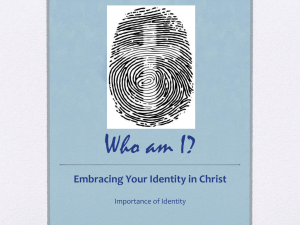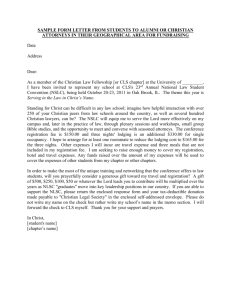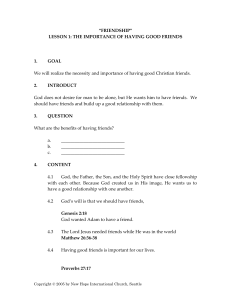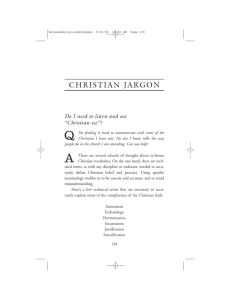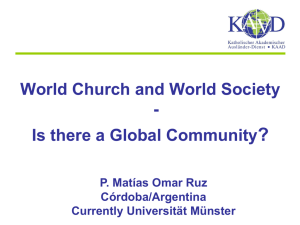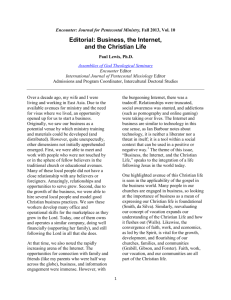AP Art History
advertisement
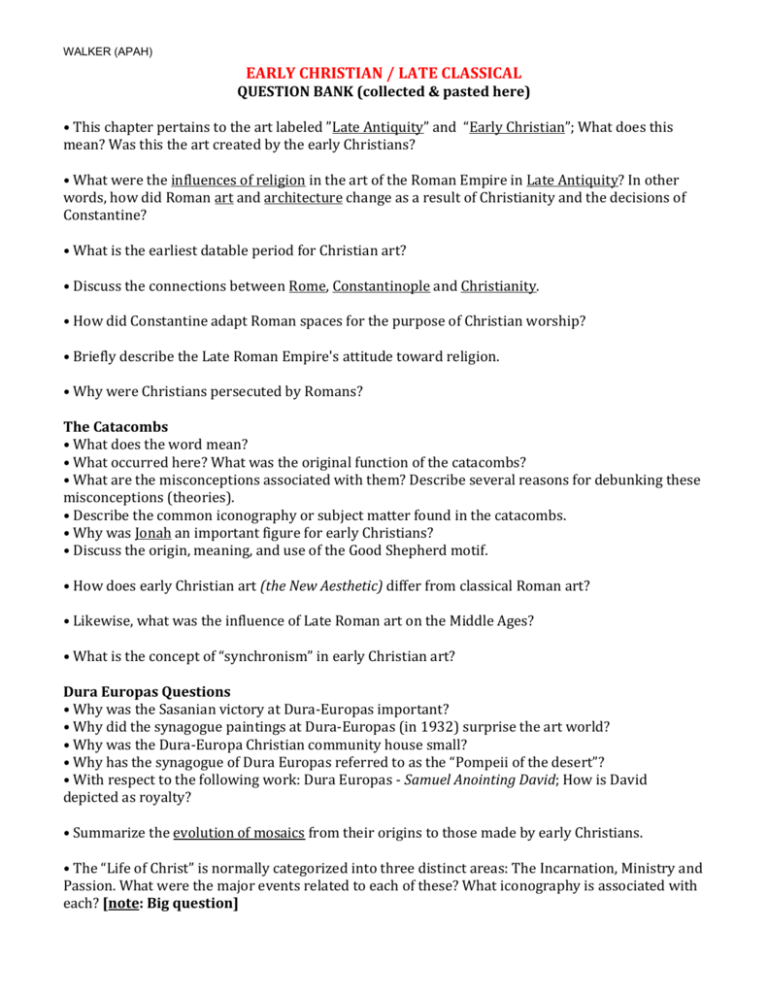
WALKER (APAH) EARLY CHRISTIAN / LATE CLASSICAL QUESTION BANK (collected & pasted here) • This chapter pertains to the art labeled ”Late Antiquity” and “Early Christian”; What does this mean? Was this the art created by the early Christians? • What were the influences of religion in the art of the Roman Empire in Late Antiquity? In other words, how did Roman art and architecture change as a result of Christianity and the decisions of Constantine? • What is the earliest datable period for Christian art? • Discuss the connections between Rome, Constantinople and Christianity. • How did Constantine adapt Roman spaces for the purpose of Christian worship? • Briefly describe the Late Roman Empire's attitude toward religion. • Why were Christians persecuted by Romans? The Catacombs • What does the word mean? • What occurred here? What was the original function of the catacombs? • What are the misconceptions associated with them? Describe several reasons for debunking these misconceptions (theories). • Describe the common iconography or subject matter found in the catacombs. • Why was Jonah an important figure for early Christians? • Discuss the origin, meaning, and use of the Good Shepherd motif. • How does early Christian art (the New Aesthetic) differ from classical Roman art? • Likewise, what was the influence of Late Roman art on the Middle Ages? • What is the concept of “synchronism” in early Christian art? Dura Europas Questions • Why was the Sasanian victory at Dura-Europas important? • Why did the synagogue paintings at Dura-Europas (in 1932) surprise the art world? • Why was the Dura-Europa Christian community house small? • Why has the synagogue of Dura Europas referred to as the “Pompeii of the desert”? • With respect to the following work: Dura Europas - Samuel Anointing David; How is David depicted as royalty? • Summarize the evolution of mosaics from their origins to those made by early Christians. • The “Life of Christ” is normally categorized into three distinct areas: The Incarnation, Ministry and Passion. What were the major events related to each of these? What iconography is associated with each? [note: Big question] WALKER (APAH) • While you do not need to learn all the episodes in the cycle of Jesus’s life yet, you should make a note of which ones are already familiar to you and which one you will need to study. • Early Christian art retained strong links to the classical tradition, while transforming classical subject matter into a new Christian context. Analyze a fresco, mosaic and sculpture relief from Early Christian art that illustrates this classical influence. [note: Big question] • Why does ATTA [Chapter 11] give you an overview of the life of Jesus in art, even though some of these themes, such as the “Crucifixion”, were rarely portrayed in early Christian art? • Discuss the historical developments that occurred from Early Christian period to the Late Byzantine? [note: This is a huge question, but do your best to sum up the notable events / dates.] • Explore the different portrayals of Christ in Early Christian and Byzantine mosaics. a) Start with the Good Shepherd lunette mosaic from the so-called Mausoleum of Galla Placidia. b) Next, the Transfiguration of Christ mosaic from the Monastery of Saint Catherine (Mount Sinai). c) And finally, the Christ Pantokrator mosaic from Daphni, Greece. • Why is the church of the Holy Sepulcher in Jerusalem important? • Briefly describe the state of the Empire of the West during the rule of Honorius. • Why were illuminated manuscripts made more precious and expensive than earlier ancient books / scrolls? Christian symbols: Identify the Christian symbols below and briefly describe their meaning. Dove Fish Lamb Four Evangelists Monogram of the Chi-Rho Crosses: Latin, Greek, Russian • Compare / contrast the Early Christian church of Santa Maria Maggiore to the Byzantine church of San Vitale (Ravenna) in terms of plan, architectural features and decoration. Sarcophagus Questions • How might one recognize a Christian sarcophagus? • How did Christians adapt the pagan tradition of being buried in a marble sarcophagus. (You will need to look back to chapter 10.) What kinds of stories are told on Christian sarcophagi from the late Roman Empire? • Describe the compositional format of the Sarcophagus of Junius Bassus, state the various scenes depicted and explain why the artist may have been asked to incorporate them into such a work. • Examine the Sarcophagus of Santa Maria Antiqua; Describe the representations found within the work and explain how at least one figure being depicted was” borrowed, adopted or adjusted” to suit the iconographic needs of the early Christian artists. WALKER (APAH) Old Saint Peter’s Questions • Who was the apostle that founded the Christian community in Rome? • Who commissioned the construction of what we refer to today as the Old St. Peter’s Basilica? • Name the term used to describe the entrance porch of Old St. Peter’s? • Examine the following mosaic: Christ as the Good Shepherd (Galla Placidia) at Ravenna; How is this rooted in the classical tradition? • Examine the following mosaic: The Miracle of the Loaves and Fishes; Why the stylistic change? • When / why did Christ take on imperial attributes? • Explain the themes represented in the interior decorative program of Santa Costanza. • How does ATTA discuss the portrayal of Jesus in the ivory plaque depicting the suicide of Judas and the crucifixion (11-21)? • Why is the Diptych of Nicomachi and Symmachi (11-22) significant? Other Questions grouped according to works of art (redundancy inherent): With respect to the Rossano Gospels When were they written? Why are they significant? How has the iconography shifted? How do you know? Christ Seated What is the date of this image? How does this figure show classical influences? Why is that important? Sarcophagus of Junius Bassus How does this figure show classical influences? Why is that important? How has the iconography been adapted to fit the new religion? Why is this iconography significant? Christ the Good Shepherd How does this show classical influence? Why is that important? How has the iconography been adapted to fit the new religion? What is the medium? Suicide of Judas and Crucifixion of Christ, plaque from a box How has the iconography been adapted to fit the new religion? How has the iconography shifted? WALKER (APAH) Rossano Gospels - Christ before Pilate How has the iconography shifted? Why is that important? Define these terms: Dura Europos Torah Penteteuch Eucharist Catacombs Prefiguration Lunette Orants Nave Aisles Aspe Atrium Narthex Transept Baldacchino Relics Clerestory Cruciform Codex Illuminated Manuscripts Vellum Parchment Diptych Ambulatory Baptistery Basilica Catacomb WALKER (APAH) Cloisonne Deisis House Church Icon Iconoclasm Lunette Manuscript Orant pose Pantokrator Reverse perspective Sarcophagus Scriptorium Tesserae


